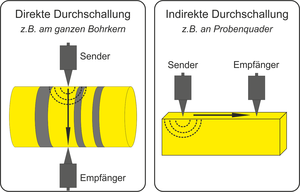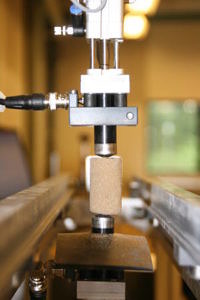Ultrasound Logger
 Ultrasound logger
Ultrasound logger
The petrophysics laboratory of the Chait of Geology has an ultrasound measuring system that enables the examination of whole drill cores as well as individual rock samples with regard to their sound transit time.
 Here, both longitudinal and shear wave velocities can be measured on cores up to a resolution of 1mm. The fully automatically controlled device ensures fast and efficient measurement of contiguous drill core intervals.
Here, both longitudinal and shear wave velocities can be measured on cores up to a resolution of 1mm. The fully automatically controlled device ensures fast and efficient measurement of contiguous drill core intervals.
The piezoelectric probes allow use free of coupling agents, so your samples are protected from contamination. Direct transmission is usually used, with the ultrasonic transmitter and receiver facing each other. Indirect transmission is also possible. To guarantee consistent quality of your measurement results, the probes are operated at a constant contact pressure of 3 bar. Ultrasonic frequencies of 20, 46, 64, 80, 250 and 350 kHz can be set.
Areas of application:
The use of ultrasound technology is a proven method for damage mapping on historic buildings made of natural stone and is therefore particularly suitable for assessing the quality of natural building stones.
The sound travel time of the longitudinal wave can be used as a porosity proxy of rocks. The modulus of elasticity (E-modulus) of the rock to be examined can be determined via the ratio of the travel times of the shear wave to the longitudinal wave and thus its compressive strength can be estimated.
Likewise, the high-resolution documentation of the ultrasonic travel time of rocks provides meaningful information for stratigraphic questions or for the assessment and characterisation of geothermal or hydrocarbon reservoirs.
Sample geometries:
With longitudinal wave measurement, drill cores up to one metre long can be examined in one piece. These can be either whole (round) or halved. In the case of shear wave measurement, plane-parallel surfaces must be present on both sides (in the case of direct through-sounding). If indirect coupling is used, a halved drill core is sufficient. Single samples of cuboid, cube or cylinder shape are also possible.
The advantages in summary:
– High-resolution and precise determination of P- and S-wave velocities
– Proxies for rock porosity, compressive strength and quality
– Individually adjustable measuring distances
– Guaranteed consistent measurement quality
– No contamination of the sample by coupling agent
Mercury Porosimeter
The petrophysics laboratory has a mercury porosimeter for analysing the pore volume and pore size distribution of communicating pore spaces in rocks. The Poremaster 60 porosimeter from Quantachrome is equipped with two low-pressure and one high-pressure station and enables the recording of a wide range of values from 950 μm to 3 nm pore diameter. The measuring principle is based on the dependence of a non-wetting liquid (mercury) which is pressed into the pore space under pressure and the pore diameter of the pores to be filled. This relationship is traditionally described by the Washburn equation. The higher the pressure applied, the smaller the pore diameter achieved. During a measurement process, intrusion points are measured, which together produce an intrusion curve. The pore size distribution is calculated from this. In addition, the bulk density and the porosity (%) can be determined.Areas of application:The areas of application of mercury porosimetry are extremely diverse. It makes an important contribution to the geosciences by determining important parameters (porosity, pore size distribution) of rocks that are required for the exploration of hydrocarbons, geothermal energy or CO2 storage. Porosity analyses are also used to determine the quality of natural building blocks and are therefore an ideal complement to the ultrasonic logger.Sample geometries:The rock samples should be in a solid state (cemented). Ideally, the samples should be cylindrical. However, it is also possible to use single fragments. Possible sample sizes (cylindrical samples, diameter*height) 1. 0.9 * 2.0 cm 2. 0.9 * 6.0 cm3. 2.5 * 3.5 cmYour advantages in summary:- Large measuring range from 950 μm to 3 nm pore diameter- Large sample throughput because two low-pressure and one high-pressure station are available- Easy measurement of different sample sizes because of various sample cells.
